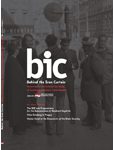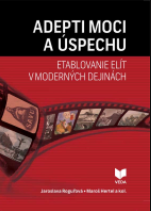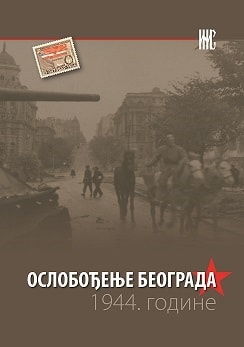
We kindly inform you that, as long as the subject affiliation of our 300.000+ articles is in progress, you might get unsufficient or no results on your third level or second level search. In this case, please broaden your search criteria.




This magazine is the English version of selected articles published in the pages of the review Paměť a dějiny (Memory and History) ISSN 1802-8241, which is issued by the Institute for the Study of Totalitarian Regimes.This magazine is the English version of selected articles published in the pages of the review Paměť a dějiny (Memory and History) ISSN 1802-8241, which is issued by the Institute for the Study of Totalitarian Regimes. The original version of the journal Paměť a dějiny (Memory and History) is the part of CEEOL also.
More...
The occupation of the Czech lands in March 1939 and Adolf Hitler’s stay in Prague on 15 and 16 March 1939 have been described in both specialist and memoir literature. Yet new archival materials relating to these events are still emerging. These include the report on the occupation of Prague Castle from May 1939 by JUDr. Karel Strnad, an official of the President’s Office, and two German documents: on President Emil Hácha’s return from Berlin on 15 March 1939 and on Adolf Hitler’s stay at Prague Castle.
More...
Adolf Hitler wrote that ‘it is impossible to let the incurably ill continue infecting the healthy’ in Mein Kampf as early as in 1924. Three years later, he mentioned the eugenic killing of newborns in his speech at the National Socialist German Workers Party (NSDAP) rally in Nuremberg: If Germany gains one million children and gets rid of the 700,000 to 800,000 weakest individuals every year, it should emerge stronger ultimately. The greatest hazard for us is not enabling the natural selection process, thus losing the possibility of gaining capable individuals.
More...
The 18th of October 2014 marked the 75th anniversary of the departure of the very first transport of European Jews in the history of the holocaust – one that left Ostrava for Nisko upon San in the eastern part of the General Government where the Nazis planned to set up an extensive “reservation” for Jews displaced from the conquered territories and the whole of Germany. As part of the Nisko Plan , a total of seven transports with more than five thousand Jews departed from Ostrava, Katowice and Vienna in the latter half of October 1939. Their journey materialised even though, by the time of departure of the first transport, the top Nazi officials had dismissed the entire plan of establishing a Jewish reservation between the Rivers Vistula and Bug. The ensuing destinies of thousands of Jewish deportees varied; however, most of them were to die or suffer in Nazi as well as in Soviet prisons and camps.
More...
This magazine is the English version of selected articles published in the pages of the review Paměť a dějiny (Memory and History) ISSN 1802-8241, which is issued by the Institute for the Study of Totalitarian Regimes.This magazine is the English version of selected articles published in the pages of the review Paměť a dějiny (Memory and History) ISSN 1802-8241, which is issued by the Institute for the Study of Totalitarian Regimes. The original version of the journal Paměť a dějiny (Memory and History) is the part of CEEOL also.
More...
English journalist Gitta Sereny’s book of interviews with Franz Paul Stangl, a participant in the Nazi “euthanasia” programme and the commander of the annihilation camps in Treblinka and Sobibór in occupied Poland, Into that Darkness: From Mercy Killing to Mass Murder, was published in the UK and the USA in 1974. The extensive tome brought a direct testimony from one of the prominent perpetrators of Nazi crimes while touching on the involvement of Germans from Bohemia in the Third Reich’s annihilation programmes.
More...
This magazine is the English version of selected articles published in the pages of the review Paměť a dějiny (Memory and History), which is issued by the Institute for the Study of Totalitarian Regimes.This magazine is the English version of selected articles published in the pages of the review Paměť a dějiny (Memory and History) ISSN 1802-8241, which is issued by the Institute for the Study of Totalitarian Regimes. The original version of the journal Paměť a dějiny (Memory and History) is the part of CEEOL also.
More...
This magazine is the English version of selected articles published in the pages of the review Paměť a dějiny (Memory and History), which is issued by the Institute for the Study of Totalitarian Regimes.This magazine is the English version of selected articles published in the pages of the review Paměť a dějiny (Memory and History) ISSN 1802-8241, which is issued by the Institute for the Study of Totalitarian Regimes. The original version of the journal Paměť a dějiny (Memory and History) is the part of CEEOL also.
More...
The independence of the Republic of Estonia was proclaimed exactly today 92 years ago. Today is Independence Day in Estonia. Estonia lost its independence in 1940 according to the secret protocol of the non-aggression agreement between the Communist Soviet Union and Nazi Germany and did not regain it after the end of the WWII. Th e occupation and annexation of the Baltic States was never recognised by the United States of America and other Western countries. Estonian diplomatic representations were active in the United States and the United Kingdom for the duration of the Cold War. Estonian passports issued by these representations were accepted as valid travel documents in many Western countries.
More...

Tido J. Gašpar začal popri svojej umeleckej tvorbe produkovať politicky angažovanú publicistiku už v období prvej Československej republiky (ČSR). Postupne, najmä v priebehu 30. rokov sa politicky angažovaná publicistika dostávala do centra jeho tvorivých a publikačných aktivít. Paralelne so zvyšovaním počtu politicky angažovaných článkov sa jeho vlastná spisovateľská tvorba začala radikálne umenšovať, až sa napokon po etablovaní ľudáckeho režimu po 6. októbri 1938 vytratila takmer úplne. V našom príspevku sa chceme zamerať na poslednú etapu Gašparovej politickej publicistiky, ktorú tvorilo obdobie existencie Slovenskej republiky v rokoch 1939 – 1945 a v rámci nej sa venovať jej dominante, ktorú predstavovala ideologická konštrukcia slovenského národného socializmu. Gašpar bol totiž prívržencom pokračovania tzv. slovenskej revolúcie v národno-socialistickom duchu a v tomto smere sa zaraďoval do radikálneho krídla Hlinkovej slovenskej ľudovej strany (HSĽS) pod vedením Vojtecha Tuku a Alexandra Macha. V tejto súvislosti je zaujímavou skutočnosť, že do aktívnej politiky Gašpar nevstúpil v období demokratickej 1. ČSR, ale až v podmienkach ľudáckeho režimu. Svoj vstup do politiky Gašpar aspoň retrospektívne vnímal ako nevyhnutný kvôli potrebe „slú- žiť národu“: „Pudila nás láska k národu. Boli sme ľuďmi ťažkej dejinnej chvíle. Chceli sme národ zachovať!“1 Jednou z motivácií Gašparovho vstupu do aktívnej politiky teda bolo podľa jeho vyjadrenia úsilie „zachovať národ“ vo vtedajších neistých podmienkach, keď geopolitická situácia nevyznievala pre ČSR pozitívne.
More...
WWII was aproaching its end in fall 1944. Italy, member of the Axis had already capitualted. German armed forces suffered grave defeats both on Western and Eastern fronts. They were also forced to start withdrawing from Greece through the vallies of the Vardar and the Morava. The Chetnik movement of Dragoljub Draža Mihalović was also in bad shape at that time. After a number of admonitions to start military actions against the occupying forces, the Western Allies withdrew their military missions from the Staff of Supreme Command as well as from other Chetnik staffs. Furthermore, they withheld military and every other kind of aid. Under the pressure of the British government, the King and the Yugoslav exile government have given them up too. The increasingly difficult military and political situation of the movement of Dragoljub Draža Mihalović spurred the gathering of the Central Nationa Committee whose permanent session started in the village of Milićevci near Čačak on September 8, 1944. Apart from making combinations about the make-up of the „Chetnik government“, the possibility of the Russian crossing of the Danube into Serbia and Yugoslavia was discussed at the meeting. Having crossed the Yugoslav-Romanian border at Turnu Severin on September 6, 1944, the units of 3rd Ukrainian Front of the Red Army, together with the units of the People’s Liberation Army dispersed the German, Chetnik, Nedić and Ljotić forces and prepared to take starting positions for the begining of the Belgrade operation. On hearing that the Red Army units were crossing into Serbia and in order to butter up to the command of the Soviet troops, the commander of the Rasina-Toplica corps group colonel Dragutin Keserović immediately undertook sabotage actions, obstructing German transports and he started attacking German forces. He ordered that German lines of communication be severed between Vrnjačka Banja and Kraljevo. Part of the Toplica Corps was saddled with the task to do the same between the village of Stopanje and Trstenik. The third part of his forces had the task to cut off the communication between Kruševac and Stalać. Chetnik forces of over 10.000 soldiers were used for these actions. At the intervention of the leadership of the People’s Liberation Army of Yugoslavia, the attempt at cooperation between the Chetniks of Draža Mihalović and the Red Army units turned out to be a total failure since it was known that some Chetnik commanders continued colaborating with Germans. For the leadership of the Red Army the Chetniks became the enemy force in Serbia which was to be destroyed together with occupying and other Quisling forces. Part of the members of Chetnik units was disarmed and set free, whereas many joined the units of the People’s Liberation Army of Yugoslavia and took part in the fight against occupiers and their collaborators. The Chetnik forces which managed to avoid being disarmed, withdrew together with their commanders and the Supreme Command simultaneously with the occupying forces in the previously determined direction of Bosnia and further to the West where they met with tragic fate. Smaller Chetnik groups which remained in some parts of Serbia organized terrorist activities for some time after the end of WWII until they were completely destroyed.
More...
In the postsocialist regimes the rehabilitation of the quislings is a part of the useful new past. The article deals with the Serbian conservative attempts to rehabilitate serbian quislings in WW 2. The paper presents some forms of actually anti-antifascism. The former prescribed communist antifascism is replaced by anticommunist anti-antifascism. It was supposed the connection between economic privatization and a strong shift to the right awareness of the past. Quislings should be rehabilitated not only for normalizing nationalism but also because of the suppression of the Left, which should deprive her important moralpolitical capital – antifascism.
More...
U kontekstu naglog uspona fašizma u Evropi i njegove pobede u pojedinim zemljama, jedno od pitanja koje se postavljalo u beogradskoj javnosti, odnosilo se na mogućnosti njegove pojave i u Jugoslaviji, i u skladu sa tim, na analize uslova koji u zemlji postoje za eventualni razmah fašističkih ideja. Nasuprot dominantnom stavu da u zemlji nema fašističkih pokreta, levičari su registrovali njihovo prisustvo, posebno izraženo u rasističkim obeležjima. Demokratskoliberalno stanovište je odbacivalo ove teze sa obrazloženjem da se fašizam uglavnom javlja u gradovima, a da u zemlji seljaka fašističke ideje mogu da nastanu samo kao plod kafanskih razgovora. Po mišljenju intelektualaca ove struje, socijalni uslovi u Jugoslaviji nisu bili pogodni za njegov razvoj, a ideje pojedinih pokreta koje su „ličile“ na fašizam, uglavnom su ocenjivali kao marginalne i potpuno bezopasne. Minimizujući fašističku opasnost u zemlji, liberalno stanovište ni u Ljotićevom pokretu nije videlo sklonost ka fašizmu, već samo njegove „primese“, „loš surogat“ i „neozbiljna oponašanja fantasta“, sklonijih diktaturi nego temeljima ove ideologije. Ambivalencija konzervativnih krugova ispoljavala se i u ovom pitanju. Fašističke ideje su odbacivane kao i teze da su prisutne u zemlji, ali su se istovremeno za Jugoslaviju tražila rešenja koja su uzor pronalazila upravo u njima. Desničari su odricali da su i sami nosioci fašističkih ideja, ali ne zato što se sa njima nisu slagali, već što su verovali da su „novi nacionalizmi“ – fašizam i nacionalsocijalizam – specifično italijanski i nemački produkt, dok je ideologija Zbora, iako sastavni deo globalne pojave „novog nacionalizma“, autentična domaća tvorevina.
More...
U oktobru 2008. godine Latinka Perović je napunila 75 godina života. Knjiga “Snaga lične odgovornosti”, zbirka članaka njenih prijatelja i saradnika, je izraz poštovanja njenom dugogodišnjem istraživačkom radu i zalaganju za razumevanje Srbije i njenog napora da se modernizuje. Ova knjiga je omaž njenom životnom zalaganju za istinu, toleranciju, individualno poštenje i hrabrost, odgovornost prema vlastitoj zemlji. Knjiga je takođe počast Latinki Perović – čoveku, istoričaru, političaru i, iznad svega, prijatelju i saradniku. Među srpskim istoričarima, Latinka Perović je verovatno uložila najveći trud da se pronikne u početke moderne istorije Srbije tokom XIX veka, bez čega se ne može razumeti ni aktuelna drama srbijanskog društva u pravljenju bilansa dvovekovnog lutanja. Isto tako, nije moguće dati odgovore na sve dileme sa kojima se Srbija na dramatičan način suočava bez uvida u suštinu dugotrajne političke opcije, Srbije kao hegemona na Balkanu, koja je završila u zločinu. U jednom razdoblju, dok je bila istaknuti političar, Latinka Perović je duboko uvažavala svu kompleksnost jugoslovenske federacije, suprotstavljajući se konstatntnom odbijanju Srbije da pristane na napor koji takva državna zajednica zahteva. Ona je u tom pogledu jedna od retkih koja je razumela tu složenu državnu zajednicu i potrebu za ravnopravnim odnosima između svih republika, bez čega takva zajednica nije moguća. Zato je i njeno razumevanje raspada Jugoslavije jedinstveno među, kako srpskim istoričarima, tako i među političarima. Ova knjiga, kao izraz našeg dubokog poštovanja za Latinku Perović, istovremeno je i pokušaj odupiranja marginalizaciji njene pojave, njenog rada i razumevanja Srbije. Bez takvog uvida i razumevanja, Srbija ne može istinski postati deo zajednice evropskih zemalja.
More...
On the most general level, it is evident that transnational activities and structures play a decisive role in our current globalized world. Accordingly, research focused on the transnational level has gained importance in the fields of political science and sociology. The past two decades of social science research have seen a number of publications written in the area. They include Císař 2004; Kolářová 2009; Della Porta, Tarrow 2005; Imig, Tarrow 1999, 2001; Snow, Benford 1999; Tarrow 1998; and Tarrow 2005. It is noteworthy that each of these researchers has chosen to examine transnationalism in the context of social movements.
More...
For the Russian Federation, the most important current issue in the scope of history is the strengthening of belief in the great victory of the USSR over Nazism and, as Jolanta Darczewska writes, a rehabilitation of the special services, as well as a change in the assessment of the deeds of Stalin. The issue of cooperation between the USSR and Hitler before 1941, which, in Russian historiography, is the beginning of the Great Patriotic War, has become quite a problematic question in this context. In this regard, we can observe a number of activities in Russia, the purpose of which is to relativise such events as the secret protocols to the Molotov-Ribbentrop Pact or the Katyń Massacre (the murder of Polish officers, non-commissioned officers and other individuals in 1940); ethnic genocide as a part of the ‘Polish Operation of the People’s Commissariat for Internal Affairs’, i.e. NKVD (1937-38); the joint Soviet-German parade in Brest; and the NKVD–Gestapo methodological conferences (1939-1940). The same applies to 17 September 1939 – i.e. the aggression of the USSR against Poland. This text will be devoted to the methods of falsifying this event by the Russian Federation.
More...